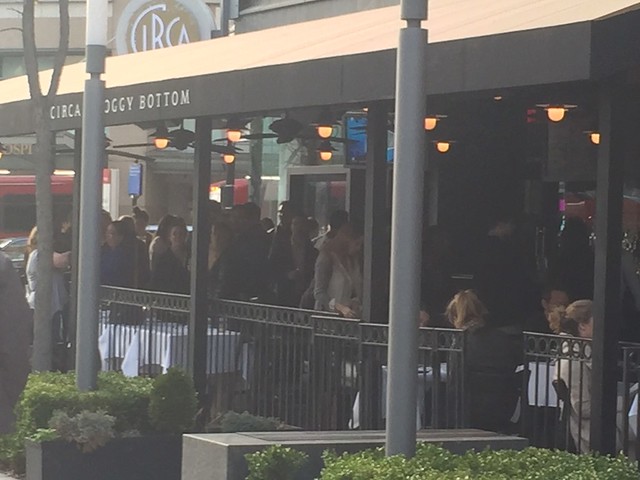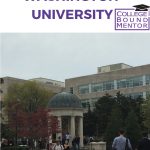George Washington University
Visited by Lisa Bleich and Beth Cassie
May, 2016

We spent a week in Washington DC touring colleges through an international relations/studies lens. We were fortunate to stay right in the heart of the foggy bottom where one of George Washington University’s three campuses is located. The Foggy Bottom campus houses 1,100 students and covers a span of four blocks by four blocks.
The university has done a good job of buying up all the property to make it all feel like it is part of GW. There are two very small “squares,” with a little lawn, but no large grassy quad area to speak of. GW operates a frequent shuttle to its Mount Vernon Campus, a greener campus with athletic facilities and housing for 700 students located about 12-18 minutes away depending on traffic.
All students will engage with both campuses. Some freshmen may end up living at the Mt. Vernon campus, but most opt to stay in the large residential dorms right in the heart of DC. GW also just added a third campus, a few blocks away from the Foggy Bottom campus, when they merged with the Corcoran School of the Arts and Design.
The area in and around campus is bustling at all hours of the night. The first night we took a walk around the area to orient ourselves and saw students studying, together and alone, in the engineering and science building or grabbing a quick bite at Whole Foods or one of the many local eateries or bars. GW food service plan allows students (or parents) to preload dining dollars to use at local eateries. As a result, the food costs can add up because all of the food is sold a la carte and there is no traditional dining facility.
The students we met seemed highly motivated “doers.” They were described by one of the international studies faculty, Professor Sutter, as open-minded, having a sense of adventure and exploration, politically aware, ambitious, independent, and outspoken. He commented on how GW students don’t want to be led by a faculty member abroad, they want the independence to go on their own.
This makes sense because the DC location is what attracts most students to GW and they want to make the most of it. They can deal with deal with large classes and are city-smart and engaged with a strong global awareness.
There is always a lot to do in DC from free concerts to museums to lectures to shopping and bar hopping in Georgetown.
Career Advising
GW has implemented a robust career advising program starting as early as freshman year. The career center divides the staff by industry career coaches to match students with experts in their intended field. The career advisors are broken into the following areas:
- International Affairs
- Education and Communications
- STEM
- Communications
- Business for non business majors
- Career Explorations Coach
- Arts, Communication and Media Coach for Corcoran
Coaches help students find internships, determine the best career path and help them secure jobs upon graduation. Internships are abundant in DC, and they are not limited to government positions, in fact non government positions are more abundant.
Career Services also has Employer Development Consultants whose job is to connect with employers and bring them to campus and post jobs. EDCs will also take students to various sites such as the CIA and talk about job opportunities. Although it is highly competitive to get an internship with Intelligence offices with almost a year lead time, students who do get an internship there are likely to get a job with the CIA upon graduation. Students must apply as freshmen if this is their goal.

During our student panel, the students described some of their internship experiences.
One young woman spent eight months in Scotland and worked closely with Scottish Parliament. A young man double majoring in international affairs and chemistry did an internship with group at University of Maryland who conducts anti-terrorist research on how to transport radioactive materials.
His group looked for holes in security with the goal to prevent smuggling of radioactive material into US. And finally the third student worked on the hill for two semesters for a Congressman. She also worked with a non-profit organization in Senegal helping to develop hands-on cook stove technology.
Academics
GW is definitely a school for students who want to learn from professionals in their fields and are not afraid to roll up their sleeves and get to business. We met with Professor Sutter, a PhD from Harvard who describes himself as a Professor of Practice. He taught for ten years at Georgetown and worked in DC with a focus on Asia.
He is able to share his deep work experience in Washington along with his deep academic knowledge. GW students have the opportunity to get a liberal arts education surrounded by deep practical knowledge. The interaction with faculty and the surrounding DC area is what attracts students to GW.
Professors also foster in-depth research since students work with faculty on particular projects. Academically, GW is a school for people who don’t want their hand-held and like to do things on their own. There is a lot of service learning through internships so students who are self starters and good networkers really thrive in this environment.
Professors know what’s important in the work force: Can you communicate? Can you think, speak and write clearly? Can you get along with others well? As an intern, can you add value and minimize the fact that you are cost by not calling attention to yourself? This is what it takes to succeed in Washington.

Professor Sutter said that many kids arrive having worked in Model UN in high school and want to work in State Department, but that’s not where it’s at. While there are many jobs in the government, there are way more jobs outside the government in Non Government Organizations (NGO), public health, conflict resolution or environmental organizations.
GW helps students thing beyond the obvious when looking for jobs. They also help students learn how to debate issues grounded in fact, not just opinion.
More than 50% of international studies students study abroad. Many go to Science Po in Paris or the London School of Economics where they have agreements.
Admission
GW offers two opportunities to apply early decision and they accept approximately 32% of their class through ED. Overall their acceptance rate is 32%. Applications were up 31% in 2016; GW’s test optional policy and the election year drove the growth. 10% of their students are international with China, South Korea, and India the most represented countries.
GW recalculates students’ GPAs and the average for 2015 was 3.64 and the mid range SAT was 1300 and the ACT was 29. 20% of admitted students did not submit their scores. GW moved to test optional as a way of increasing access. They also recently partnered with the Posse foundation and also offer 10 full scholarships for DC students. Merit money is also available for students.
Summary
GW is a fantastic school for politically and globally aware self-starters who thrive in a city environment and enjoy debating world issues.
George Washington University
2121 I St NW
Washington, DC 20052
(202) 994-1000
www.gwu.edu


